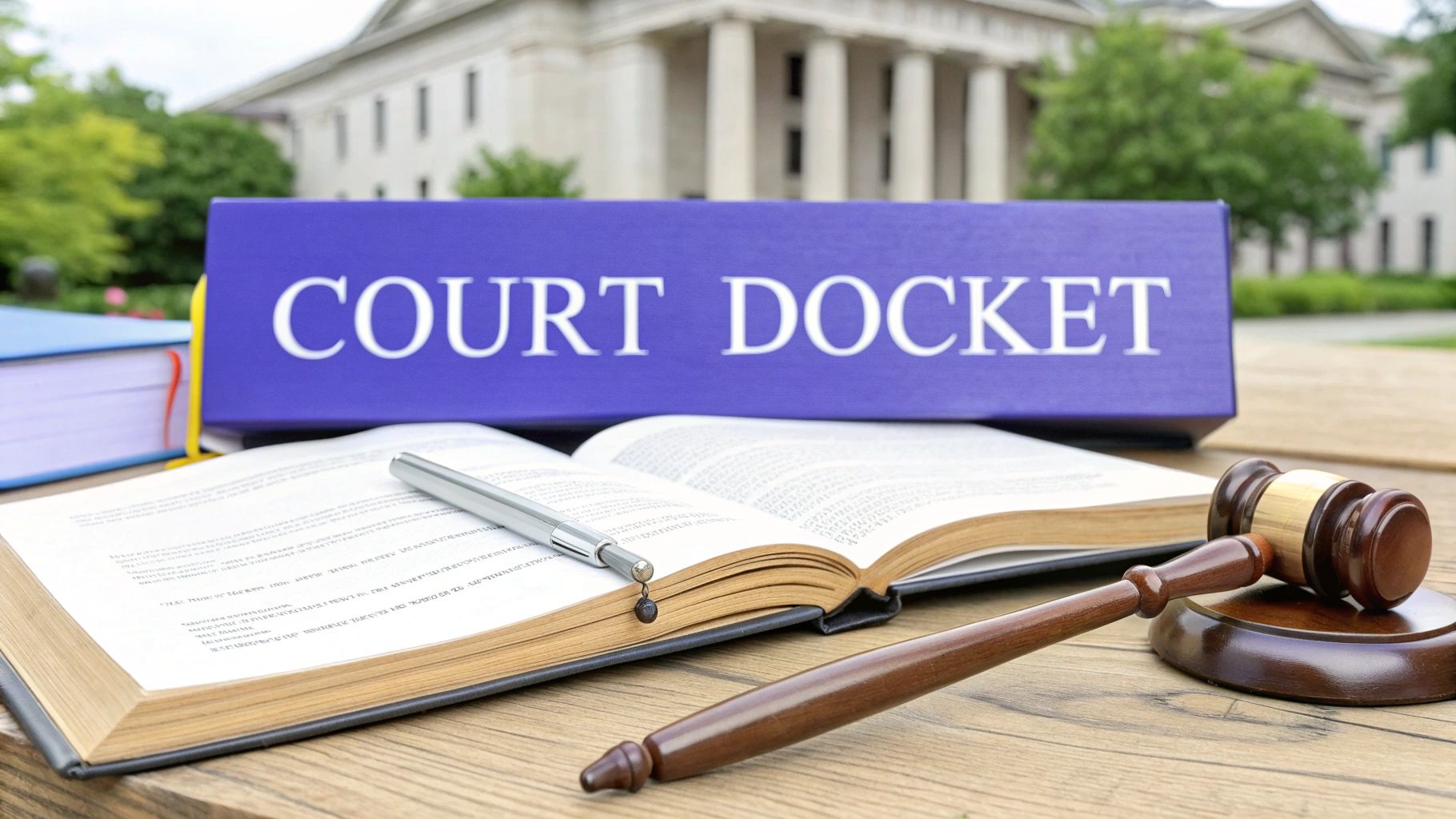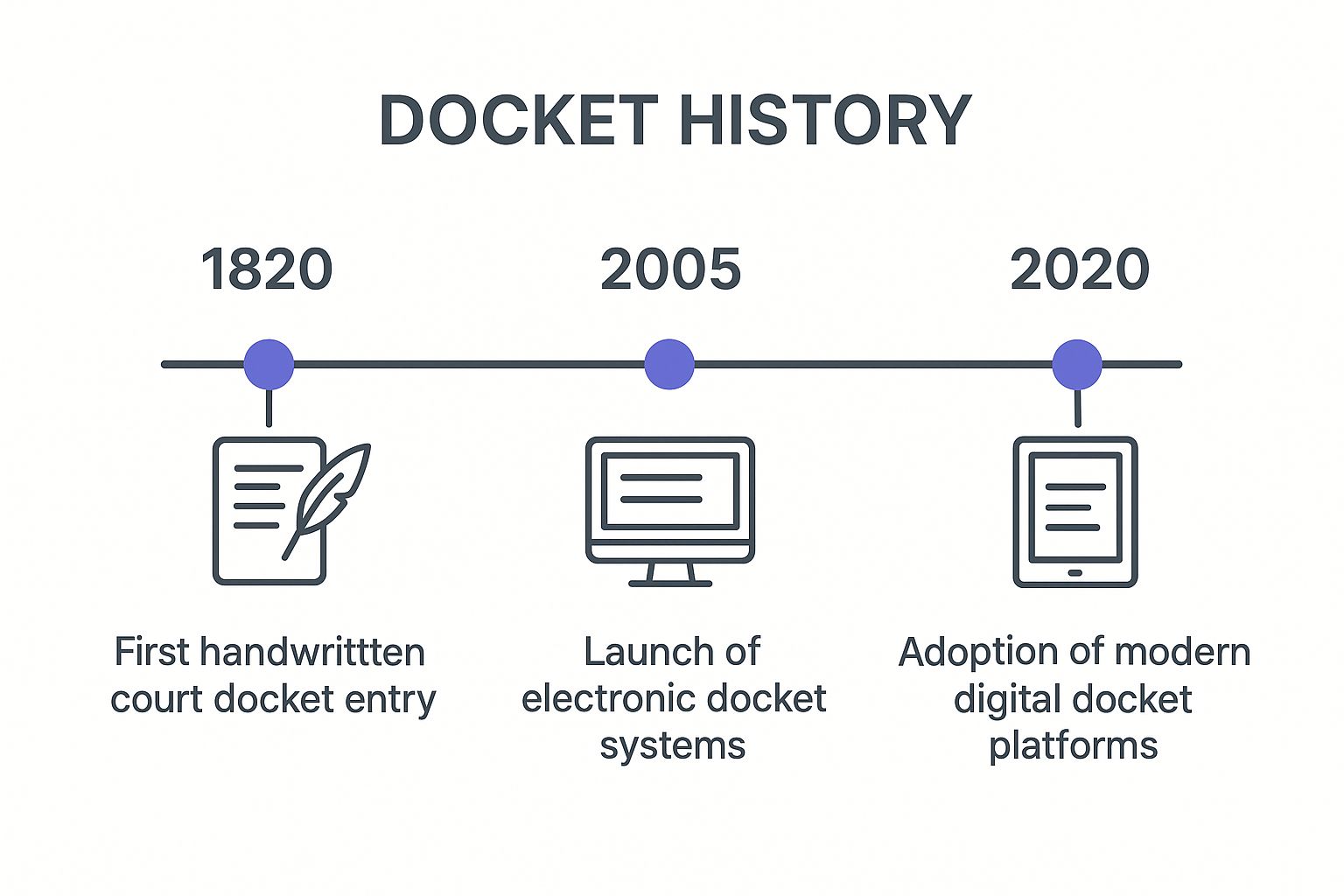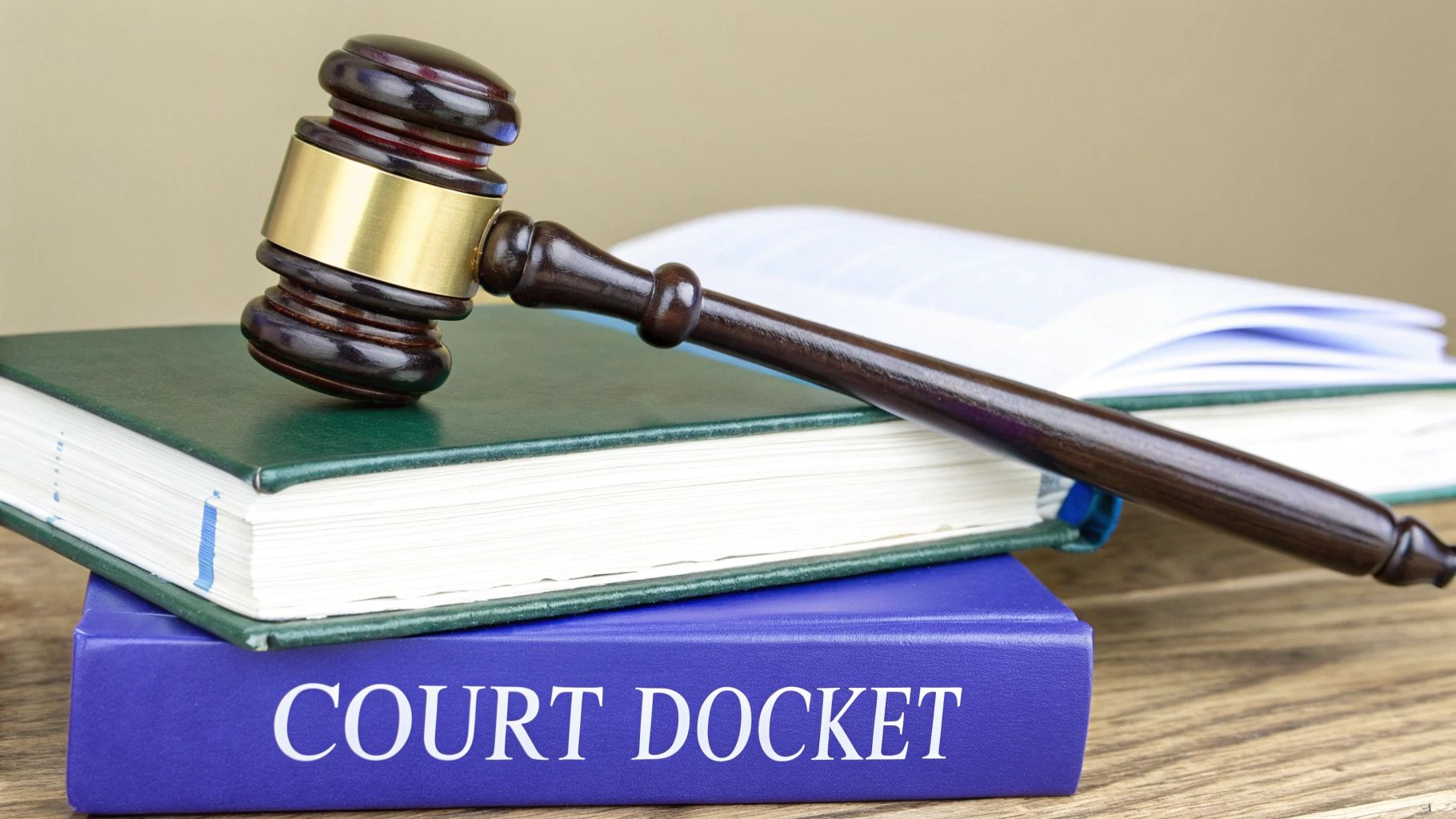
At its core, a court docket is the official logbook for a legal case, meticulously kept by the court. Think of it as the case's official story, a chronological summary of every single event from the initial filing to the final judgment. The term itself can feel like dense legal jargon, but the concept is surprisingly straightforward once you peel back the layers.

Imagine a legal case as a long and complicated road trip. The court docket is its GPS history, tracking every turn, stop, and destination along the way. This official record ensures there’s a clear, sequential history of the entire proceeding, accessible to everyone involved.
Just like a package needs a tracking number, every legal case gets a unique identifier. This is the docket number. It’s assigned the moment a case begins and stamped on every document filed, making it the primary tool for keeping everything organized. When a lawyer files a motion, the clerk records it. When a judge issues an order, that gets added too.
Key Components of a Court Docket
So, what exactly will you find on a docket sheet? While the format can vary by court, the core components are pretty standard. This table breaks down the essential information.
| Component | What It Is | Why It's Important |
|---|---|---|
| Case Information | The basic details: case name, court, and judge. | Provides the who, what, and where of the lawsuit at a glance. |
| Docket Number | The unique ID assigned to the case. | It’s the master key used to track and retrieve all case documents. |
| Parties & Attorneys | A list of all plaintiffs, defendants, and their legal counsel. | Clearly identifies everyone officially involved in the case. |
| Chronological Entries | A date-stamped list of every filing, motion, order, and hearing. | Creates a complete, sequential narrative of the case's progress. |
| Document Filings | Links or references to all documents filed with the court. | Allows you to access the actual complaints, motions, and evidence. |
| Court Actions | Records of all decisions and orders made by the judge. | Shows the official rulings and directions from the court. |
Understanding these components helps you navigate the docket and piece together the story of the case, from its first steps to its final resolution.
Why The Docket Number Is So Important
The docket number is the key to unlocking a case's entire history. Without it, finding specific documents in a court system that handles thousands—or even millions—of cases would be nearly impossible. It acts as the central link, tying every piece of information to the correct case, from minor procedural filings to major judicial decisions.
This systematic approach is the bedrock of our legal process. It provides a transparent and verifiable record that holds the court system accountable. In most situations, anyone with the docket number can look up the case and follow its progress.
Key Takeaway: A docket isn't just a list; it's the official narrative of a legal case. It tells the story of the proceedings through a chronological record of every document filed and every action taken by the court.
The Surprising History of the Docket
To really get what a docket is today, it helps to look back at its surprisingly long history. The idea isn't some modern invention; its roots stretch back centuries. Long before digital files, the first dockets were simple, practical tools designed to bring a little order to the chaos of legal cases.
The term itself first popped up in late medieval England as "doggette" back in 1485. In those days, a docket was just a big, physical book. Court clerks would use it to jot down short summaries of every document filed and every event that happened in a case. This practice of "docking," or shortening, long-winded parchments into brief notes, became the bedrock of keeping court records straight. You can learn more about the docket's early evolution and its role in official record-keeping.
From Parchment to Pixels
For hundreds of years, these handwritten ledgers were the gold standard. The job of the "Clerk of the Dockets" was even an official position, a role entirely dedicated to maintaining these crucial records and ensuring every case had a clear, chronological paper trail. But this manual system, while revolutionary for its time, was slow and stuck in one place.
The real game-changer was the digital age. It transformed the docket from a dusty book on a shelf into a searchable electronic database, which made accessing case information faster and easier than ever before.
This graphic shows the leap from those early handwritten entries to the powerful digital systems we use now.

The timeline really puts into perspective how quickly technology took the docket's core function and supercharged it. What once meant a trip to the courthouse and a friendly chat with a clerk is now often available with just a few clicks.
From Summary to System: The fundamental idea of the docket—to summarize what’s happening in a case—has stayed the same for over 500 years. The only thing that’s changed is the technology, which has turned a simple summary book into the powerful administrative backbone of the entire judicial process.
How to Read a Modern Docket Sheet
At first glance, a modern docket sheet can look like a wall of confusing codes, dates, and legal jargon. But if you know how to read it, it tells a clear story. The best way to think about it isn't as a dry legal document, but as a detailed script for a play—each entry marks a new scene in the case's journey.

The first step is just getting your bearings. Look at the very top for the case caption, which lists the court, the names of all plaintiffs and defendants, and the all-important docket number. This is the "who's who" of the case and the unique ID you'll use to track it.
From there, you'll see the main body of the docket: a chronological list of every event. This is where you follow the plot, one entry at a time.
Decoding the Narrative Flow
To really understand what's happening, you need to recognize the different types of entries and what they signal about the case's momentum. You’ll usually see a mix of motions, orders, notices, and filings.
- Motions: These are simply requests from one party asking the court to take a specific action. A "Motion to Dismiss," for example, is one side asking the judge to throw the case out entirely.
- Orders: These are the judge's official decisions. They are often direct responses to motions. An "Order Granting Motion to Dismiss" means the judge agreed, and the case is over.
- Filings: This is a catch-all term for any document submitted to the court. It could be the initial complaint that started the lawsuit, the defendant's answer, or a key piece of evidence.
- Notices: Think of these as official announcements from the court. A "Notice of Hearing" is just the court setting a date and time for everyone to show up.
This skill of interpreting documents in sequence is crucial in the legal world, and it's not just limited to dockets. In fact, our guide on how to read contracts touches on similar principles of breaking down complex information step-by-step.
Key Insight: The real power of a docket sheet lies in its chronological structure. By reading the entries in order, you can watch a legal strategy unfold in real-time. You can see every action and reaction, pinpointing critical moments like a major ruling or the submission of game-changing evidence. It’s the procedural story of any lawsuit, laid out for you to read.
Why Dockets Are Essential for Court Management
A court docket is far more than a simple list of cases. It's the operational backbone of the entire justice system, the master log that keeps everything from spiraling into administrative chaos. Without it, the sheer volume of legal proceedings would be completely unmanageable.
Think of it as the air traffic control system for a busy airport. Every plane (a legal case) follows a specific flight plan (the docket) that tracks its every move from takeoff to landing. This system is what keeps the judicial process from grinding to a halt under its own weight. Judges and court administrators rely on it to keep the gears of justice turning smoothly.
The docket serves as the official, formal record of everything that happens in a case—every document filed, every hearing scheduled, and every action taken by the judge. The scale of this task is massive. In 2023 alone, U.S. federal courts juggled roughly 370,000 new civil cases and 78,000 criminal cases. You can explore more about the docket's central role in the legal process on library.fiveable.me.
Ensuring Fairness and Transparency
Beyond just logistics, the docket is a cornerstone of fairness and transparency in our legal system. By creating a public, chronological record, it holds the courts accountable to the people they serve.
Here's how it accomplishes this:
- Tracking Deadlines: The docket provides a clear timeline, making sure everyone involved meets critical deadlines for filing motions or responses.
- Procedural Fairness: It acts as proof that all parties were properly notified of hearings and filings, which is a key part of due process.
- Public Accountability: It opens the doors of the courthouse, allowing the public and media to follow a case's progress and reinforcing the principle of open justice.
In essence, the humble docket is a powerful instrument that enables the orderly, efficient, and transparent administration of justice on a massive scale. It transforms a potentially chaotic flood of information into a structured, manageable process for everyone involved.
Finding and Accessing Court Dockets Online
Knowing what a docket is and how to read one is a great start, but the real question is: where do you actually find one? Fortunately, technology has made digging up these crucial legal records easier than ever.
For federal cases, your first and most important stop is a system called PACER, which stands for Public Access to Court Electronic Records.

Think of PACER as the central online library for every U.S. District, Bankruptcy, and Appellate court. Once you create an account, you can search for cases by party name, case number, or court, giving you access to the docket sheet and all its associated documents. It’s incredibly powerful, but this convenience usually comes with a price tag.
While searching is free, PACER typically charges a small fee per page to view or print documents. Those cents can add up fast, especially on a complex case. In fact, the Administrative Office of the U.S. Courts, which defines the docket as a chronological record, reported that PACER generated over $150 million in fiscal year 2020 alone. You can read more about how the U.S. Courts manage docket access and the role the system plays.
Looking Beyond Federal Courts
So what about state and local cases? This is where things get a little less straightforward. Unlike the unified federal PACER system, each state handles public access to court records in its own way.
The good news is that most states now have their own online portals, many of which are completely free to use. A quick search for "[Your State] court records" will usually get you started. Be prepared, though, as the level of access can vary quite a bit.
- Free Online Access: Many states offer robust, free search tools for their court dockets.
- Paywalled Systems: Some states run systems similar to PACER, where you'll have to pay fees to view or download documents.
- In-Person Only: For some jurisdictions, especially for older cases or certain courts like small claims or traffic, the only way to see the docket is to take a trip down to the courthouse clerk's office.
Practical Tip: When you're looking for a state or local case, start your search on the specific county court's website. They often provide the most direct and user-friendly tools for their own records. This little trick can save you the headache of navigating a complex statewide system and get you the information you need much faster.
Frequently Asked Questions About Court Dockets
Even after you get the hang of what a docket is, a few common questions tend to pop up. Let's walk through some of the most frequent ones to make sure you have a complete picture of how this fundamental legal tool actually works.
Think of this as rounding out your knowledge. By tackling these specific points, you can feel more confident finding and making sense of these important legal records.
What Is the Difference Between a Docket and a Court Calendar?
It's easy to mix these two up, but they serve completely different functions. The key difference comes down to their purpose and how much detail they contain.
A docket is the complete, official history of one specific case. Imagine it as a detailed biography, chronicling every single filing, motion, order, and event from the day the case was opened.
A court calendar, on the other hand, is just a schedule. It simply lists the hearings, trials, and other appointments set for a particular courtroom on a given day or week.
Here's a simple way to think about it: The docket is the entire script of a movie, from the first scene to the final credits. The court calendar is just the daily showtime listing at the local theater.
Are All Court Dockets Public Records?
In most cases, yes. The idea of open justice is a cornerstone of the legal system, meaning court proceedings and their records should be accessible to the public. You can usually find federal dockets through the PACER system, and many state courts offer online access, often for free.
However, there are some important exceptions. A judge can order a case to be sealed, which makes its records confidential. This is usually done to protect highly sensitive information. Common examples include:
- Cases involving minors, to protect their privacy.
- Disputes over valuable trade secrets.
- Matters of national security.
- Certain family law cases, such as adoptions.
When a case is sealed, its docket and all related documents are hidden from public view.
What Is a Docket Number Actually Used For?
A docket number is the unique ID code stamped on a case the moment it's filed. It works just like a tracking number for a package or a serial number on a product. Its main job is organization.
This number appears on every single document associated with the case. It's what allows court clerks, judges, and lawyers to instantly find and manage all related filings with total accuracy. Without it, sorting through the thousands of documents filed daily would be pure chaos. It ensures every motion, order, and piece of evidence lands in the right file.
Of course, knowing what these documents are is the next step. You can dig deeper into other key legal terms explained in our detailed guide.
Understanding dockets is a great first step, but what about the complex documents they contain? The Legal Document Simplifier platform uses AI to instantly convert confusing contracts, leases, and agreements into clear, simple summaries. Upload any legal document and get actionable insights in seconds, helping you save time and avoid costly misunderstandings. Try it today.